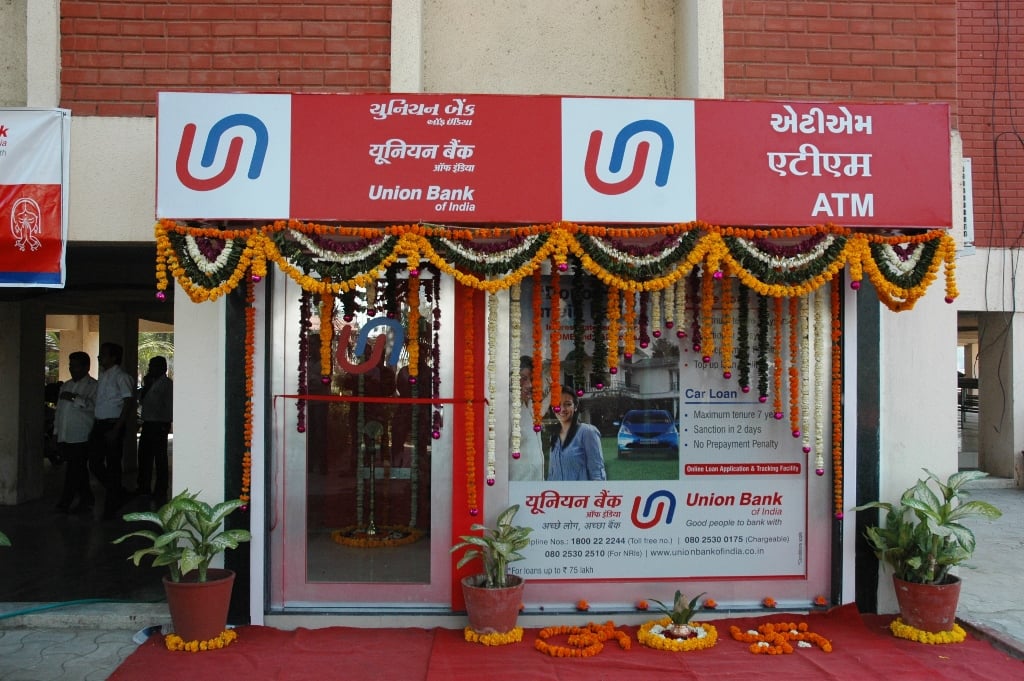Union Bank of India
Summary
- The bank has a network of 9300+ domestic branches, 12000+ ATMs, 8216 BC Points serving over 120 million customers with 78000+ employees.
- The Bank’s total business as of 31st March 2021 stood at Rs.15,77,489 crore, comprising Rs. 9,23,805 crore of deposits and Rs. 6,53,684 crore of advances.
- In year 2020 Corporation Bank and Andhra Bank merged into Union Bank of India

Company Overview
Union Bank of India (NSE:UNIONBANK) is one of the leading public sector banks of the country. The Bank is a listed entity and the Government of India holds 83.50 percent in Bank’s total share capital. The Bank, having its headquarters at Mumbai (India), was registered on November 11, 1919 as a limited company.
Recently, Andhra Bank and Corporation Bank were amalgamated into Union Bank of India with effect from 01.04.2020. Today, it has a network of 9300+ domestic branches, 11800+ ATMs, 8216 BC Points serving over 120 million customers with 77000+ employees. The Bank’s total business as of 31st March 2021 stood at Rs.15,77,489 crore, comprising Rs. 9,23,805 crore of deposits and Rs. 6,53,684 crore of advances.
The Bank also has 3 branches overseas at Hong Kong, Dubai International Financial Centre (UAE) & Sydney (Australia); 1 representative office in Abu Dhabi (UAE); 1 banking subsidiary at London (UK); 1 banking joint venture in Malaysia; 4 para-banking subsidiaries (domestic); 3 joint ventures(including 2 in life insurance business) and 1 associate - Chaitanya Godavari Gramin Bank. Union Bank of India is the first large public sector bank in the country to have implemented 100% core banking solution. The Bank has received several awards and recognition for its prowess in technology, digital banking, financial inclusion, MSME and development of human resources.1

Joint Ventures and Subsidiaries
Joint Ventures
- SUD Life Insurance
- India First Life Insurance Company Ltd.
- ASREC (INDIA) Ltd.
- India International Bank Malaysia Berhad (IIBMB)
Subsidiaries
- Union Bank of India (UK) Limited
- Union Asset Management Co. Pvt. Ltd.
- Corpbank Security Ltd.
- Andhra Bank Financial Services Limited
- Union Trustee Co. Pvt. Limited
Associates
- Chaitanya Godavari Grameena Bank
Products
Personal
- Accounts & Deposit
- Union Dial
- Loans
- Retail
- MSME
- Agri Business
- Wealth Management- Insurance, Mutual Funds, Demats
- Government Schemes
- Financial Inclusion
- CSR
- Lockers/Other Services
Corporate Loans
- Corporate Loans
- Loan Syndication & Debt Restructuring
- Other Services
Treasury & Other Products
International
- Schemes / Products / Services
- NRI ServicesTreasury & Other Products
- Remittances
Credit Cards
- Uni Carbon
- Rupay Platinum
- Rupay Select
- VISA Gold
- VISA Platinum
- VISA Signature

Industry Overview
As per the Provisional Estimate of the National Statistical Office (NSO), India’s Gross Domestic Product (GDP) in 2020-21 at with to contracted at -7.3 per cent. Real GDP at Constant Prices (2011-12) in the year FY21 is estimated at Rs 135.13 lakh crore, as against Rs 145.69 lakh crore in 2019-20. GDP at Current Prices in FY21 is estimated at Rs 197.46 lakh crore, as against Rs 203.51 lakh crore in 2019-20.
The Indian economy entered a technical recession in the first half of FY21 with GDP plunging by 24.4 per cent in Q1 FY21, 7.4 per cent in Q2 FY21. This sharp fall can be attributed to the nation-wide lockdown announced by the government during April-May 2020 to mitigate the outbreak of coronavirus, which brought economic activity to a halt in the first quarter, severely impacting the growth of industrial and services sector activities. Industry and services sector is estimated to register a contraction of -7.0 per cent & -8.4 per cent, respectively, in 2020- 21.
The agricultural sector remains a bright spot, supported by a normal monsoon, robust kharif sowing and adequate reservoir levels. Agriculture sector is estimated to see a growth of 3.6 per cent in 2020-21.2
Yield movements remained volatile in the FY 2020- 21. The hardening of yields at the beginning of Q1:2020-21 was mitigated by liquidity augmenting measures announced by RBI in the second half of April and May. With the announcement of an enhancement of Central Government market borrowings by about 54 per cent – from Rs.7.8 lakh crore to Rs.12.0 lakh crore – for 2020-21, however, the benchmark yield rose by 20 bps on May 11, 2020. In June, several factors viz., low demand for dated securities; border tensions; rating downgrade by Fitch Ratings; and supply fatigue from increased issuances of T-bills and state development loans (SDL) kept yields firm.
Subsequently, however, softening US treasury yields, fall in crude oil futures, and the announcement of special open market operations (OMOs) or “Operation Twist”, by RBI eased pressure on yields by end-June. The Reserve Bank conducted five operation twist auctions during July-September and backed them up with an increase in the limit of SLR securities kept under the held to maturity (HTM) category by 2.5 per cent of NDTL – from 19.5 per cent to 22 per cent.
Overall, the 10-year benchmark yield softened by 15 bps in Q1:2020-21. In Q2:2020-21, yields exhibited a hardening bias on a rise in fuel prices and higher inflation prints for June and July. Overall, the 10-year yield (5.79 per cent GS 2030) hardened by 12 bps in Q2, mainly reflecting a 24 bps rise in August. During Q3:2020-21, the yield softened by 15 bps from 6.04 per cent to 5.89 per cent. During Q4, yields remained range bound with an upward bias till the presentation of the Union Budget 2021- 22 on February 1, 2021.
Average G-sec yield for the FY 2020-21 was at 5.99%. Corporate bond yields too eased, tracking the movement in G-sec yields. Furthermore, the spread on corporate bonds over corresponding G-secs moderated across issuer categories and ratings spectrum.
RBI’s policy decisions
1 During FY 2020-21, the RBI has reduced the key policy rate by 40 bps on 22nd May 2020 and kept the policy repo rate unchanged during the rest of the financial year. Accordingly, the repo rate and reverse repo rate stands at a near two decadal low at 4.00 percent and 3.35 percent, respectively. The MSF rate and the Bank Rate was reduced to 4.25 per cent from 4.65 per cent, respectively. The Monetary Policy Committee (MPC) decided to continue with the accommodative stance as long as it is necessary to revive growth and mitigate the impact of COVID-19 on the economy, while ensuring that inflation remains within the target going forward.
The RBI undertook several conventional and unconventional measures in the wake of COVID-19. Other than conventional measures of policy rate reduction, the RBI introduced long term repo operations (LTROs) and targeted long-term repo operations (TLTROs) to augment system as well as sector-specific liquidity to meet sectoral credit needs and alleviate stress.
Special refinance facilities were provided to select all India financial institutions (AIFIs), while a special liquidity facility for mutual funds (SLF-MF) was introduced to ease redemption pressures. The focus was to foster congenial financing conditions without jeopardising financial stability. Further, forward guidance gained prominence in the RBI’s communication strategy to realise cooperative outcomes. The RBI ensured to support the recovery process through the provision of ample liquidity in the system, while maintaining financial stability.
Banking environment
food credit growth decelerating to 5.59% on 26th March 2021 from 6.17 per cent as on 27th March 2020. The slowdown in Scheduled Commercial Banks’ (SCBs’) credit growth during 2020-21 has been broad-based across all major sectors, except agriculture.
Credit growth to industry decelerated marginally to 0.4% (0.7% a year ago) mainly due to credit to large industries, which contracted by 0.8% in March 2021 (as compared with a growth of 0.6% a year ago). This is primarily on account of large industries obtaining financial resources from nonbank sources, while credit to medium industries registered a robust growth of 28.8% in March 2021 (as compared to contraction of 0.7% a year ago).
Slowdown in growth of personal loans continued, as it decelerated to 10.2 per cent in March 2021 from 15.0 per cent a year ago. However, vehicle loans and loans against gold jewellery continued to perform well during the month, registering accelerated growth.

Business Overview
Established in the year 1919, the Bank has 9312 branches and 3 overseas branches, 12957 ATMs across 29 States and 5 Union Territories and 78202 employees as on March 31, 2021.
The global business of the Bank stood at Rs.15,77,490 crore as on March 31, 2021.
Total Deposits increased to Rs.9,23,805 crore as on March 31, 2021. Out of this CASA share (current account and saving account) stood at 36.33 % as on March 31, 2021.
Gross Advances stood at Rs. 6,53,684 crore as on March 31, 2021.The RAM (Retail, Agriculture and MSME) sector stood at Rs.3,67,825crore as on March 31, 2021 compared to Rs. 3,39,318crore as on March 31, 2020. RAM Sector as a whole grew at an annual rate of 8.40 %.
Overseas business of the Bank stood at Rs.18,191 crore as on March 31, 2021 compared to Rs.24,345 crore as on March 31, 2020. The Bank has three overseas branches at Hong Kong, DIFC (Dubai) and Sydney (Australia). The Bank also operates in the United Kingdom through its wholly owned subsidiary, Union Bank of India (UK) Ltd
The Bank reported an Operating Profit of Rs.19,259 crore in FY 2020-21 as compared to Rs.9,181crore in FY 2019-20.
Netprofit of the Bank stood at Rs.2,906 crore in FY 2020-21.
Cost-to-income ratio of the Bank stood at 46.54 % in FY 2020-21
During FY 2020-21, Return on Average Assets stood at 0.27%, whereas Return on Equity stood at 6.68%
Amalgamation
As a part of mega consolidation of Public Sector Banks, Government of India vide gazette dated March 04, 2020 provided approval for amalgamation of Corporation Bank and Andhra Bank into Union Bank of India (Anchor Bank) and announced the said Amalgamation would be effective from April 01, 2020.
The amalgamation has significantly resulted in improving the geographical penetration of Union Bank across the country. With the amalgamation, Union Bank became the 5th largest public sector Bank in terms of business with extensive network of offerings.
Gross Non-Performing Assets (GNPA) of the Bank stood at Rs.89,788 crore as on March 31, 2021. GNPA as per cent to gross advances stood at 13.74 % as on March 31, 2021.
Net NPA of the Bank stood at Rs.27,281 crore as on March 31, 2021 and the Net NPA ratio stood at 4.62 % as on March 31, 2021.
Union Bank of India Q1FY22 results
July 29, 2021; Public sector lender Union Bank of India has reported a 255 percent year-on-year growth in Q1FY22 standalone profit, beating estimates, driven by pre-provision operating profit and other income.3
The standalone profit increased to Rs 1,181 crore in the quarter ended June 2021, from Rs 332.7 crore in corresponding period last fiscal.
Net interest income grew by 9.5 percent year-on-year to Rs 7,013.4 crore in Q1FY22, the bank said in its BSE filing.
Profit was estimated at Rs 701.7 crore and net interest income at Rs 5,891.3 crore for the quarter, according to the average of estimates of analysts polled by CNBC-TV18.
Non-interest income in Q1FY22 shot up 98.4 percent to Rs 2,901 crore and pre-provision operating profit rose 31.4 percent to Rs 5,302.81 crore compared to year-ago period.
Provisions and contingencies remained at elevated levels though declined marginally, falling 0.9 percent year-on-year and 9.7 percent quarter-on-quarter to Rs 3,523.81 crore in the quarter ended June 2021.
On the asset quality front, gross non-performing assets as a percentage of gross advances fell 14 bps sequentially to 13.60 percent and net NPA as a percentage of net advances increased 7 bps QoQ to 4.69 percent during the quarter.
References
- ^ https://www.unionbankofindia.co.in/english/aboutus-profile.aspx
- ^ https://www.unionbankofindia.co.in/pdf/ANNUAL%20REPORT_UNION%20BANK%202020-2021.pdf
- ^ https://www.moneycontrol.com/news/business/earnings/union-bank-of-india-q1-results-profit-jumps-255-to-rs-1181-crore-despite-elevated-provisions-7246841.html




